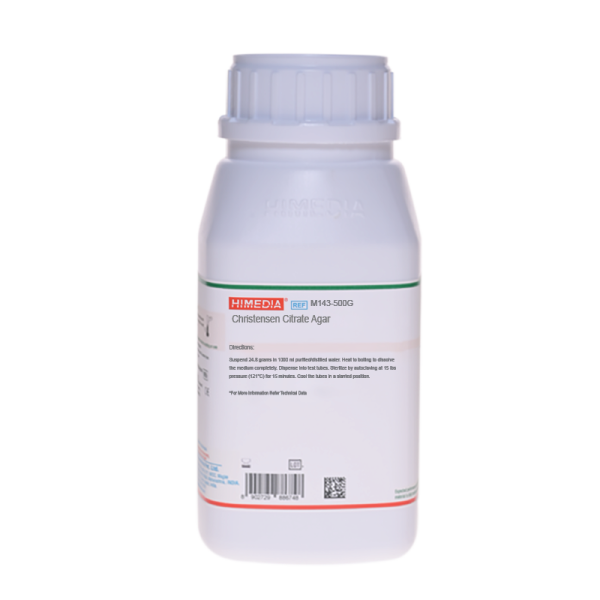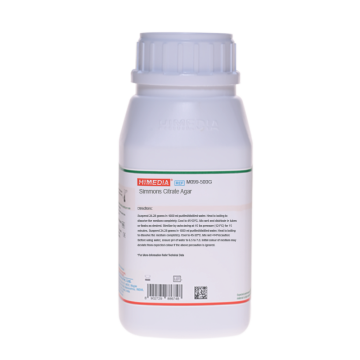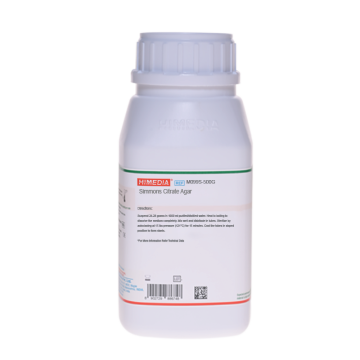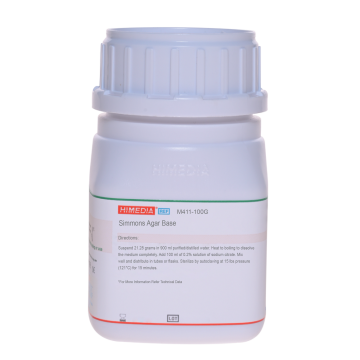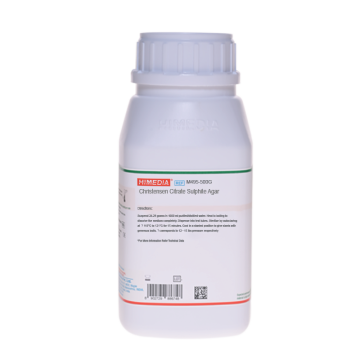 Your enquiry has been submitted
Your enquiry has been submitted
Christensen Citrate Agar
Intended Use
Recommended for the differentiation of enteric pathogens and coliforms from clinical and non-clinical samples based on citrate utilization.
Composition**
| Ingredients | g/L |
|---|---|
| Yeast extract | 0.500 |
| L-Cysteine hydrochloride | 0.100 |
| Sodium citrate | 3.000 |
| Dextrose (Glucose) | 0.200 |
| Potassium dihydrogen phosphate | 1.000 |
| Sodium chloride | 5.000 |
| Phenol red | 0.012 |
| Agar | 15.000 |
| Final pH (at 25°C) | 6.9±0.2 |
**Formula adjusted, standardized to suit performance parameters
Directions
Suspend 24.8 grams in 1000 ml purified/distilled water. Heat to boiling to dissolve the medium completely. Dispense into test tubes. Sterilize by autoclaving at 15 lbs pressure (121°C) for 15 minutes. Cool the tubes in a slanted position.
Principle And Interpretation
Christensen Citrate Agar is a modification of Christensen Iron Agar (1), which has the same formulation except the additional sodium thiosulphate and ferric ammonium citrate as described by Edwards and Ewing (2). Christensen reported that all members of genera Escherichia, Enterobacter, Citrobacter and Salmonella were capable of utilizing citrate as a source of energy while Shigella species failed to utilize citrate. Edward and Ewing (2) recommended the use of Triple Sugar Iron Agar (M021) for the determination of hydrogen sulphide production and Christensen Citrate Agar for citrate utilization. Organisms that metabolize citrate as a sole source of carbon cleave citrate to oxaloacetate and acetate via the citritase enzyme. Another enzyme, oxaloacetate decarboxylase, then converts oxaloacetate to pyruvate and CO2. Further, this CO2 combines with sodium and water to form sodium carbonate, an alkaline compound (3). As a result, the pH of medium rises and the indicator, phenol red changes from orange red to cerise. Presence of the cerise colour indicates a positive finding for citrate utilization. Medium constituent yeast extract provide the necessary nutrients mainly nitrogenous and vitamins for the growth of the organisms. L-cysteine hydrochloride is a reducing agent. Dextrose is the fermentable carbohydrate. Sodium citrate is the energy source for citrate utilizing organisms. Care should be taken while inoculating, as, a too heavy inoculum may give a false positive result (4).
Type of specimen
Clinical samples - Faeces; Food and dairy samples; Water samples
Specimen Collection and Handling:
For clinical samples follow appropriate techniques for handling specimens as per established guidelines (5,6). For food and dairy samples, follow appropriate techniques for sample collection and processing as per guidelines (7,8,9). For water samples, follow appropriate techniques for sample collection, processing as per guidelines and local standards (10). After use, contaminated materials must be sterilized by autoclaving before discarding.
Warning and Precautions :
In Vitro diagnostic Use. For professional use only. Read the label before opening the container. Wear protective gloves/ protective clothing/eye protection/ face protection. Follow good microbiological lab practices while handling specimens and culture. Standard precautions as per established guidelines should be followed while handling clinical specimens. Safety guidelines may be referred in individual safety data sheets.
Limitations :
- Before using water, ensure pH of water is 6.70-7.10. Initial colour of the medium may deviate from expected colour, if the above precaution is ignored.
- The pH affects the performance of the medium and must be correctly monitored.
Performance and Evaluation
Performance of the medium is expected when used as per the direction on the label within the expiry period when stored at recommended temperature.
Quality Control
Appearance Light yellow to light pink homogeneous free flowing powder
Gelling Firm, comparable with 1.5% Agar gel
Colour and Clarity of prepared medium Orange red coloured, very slightly opalescent gel forms in tubes as slants
Reaction Reaction of 2.48% w/v aqueous solution at 25°C. pH: 6.9±0.2
pH 6.70-7.10
Cultural Response Cultural characteristics observed after an incubation at 35-37°C for 24-48 hours.
| Organism | Growth | Citrate utilization (Colour of slant) |
|---|---|---|
| # Klebsiella aerogenes ATCC 13048 (00175*) | luxuriant | positive reaction, cerise colour |
| Escherichia coli ATCC 25922 (00013*) | luxuriant | negative reaction, no colour change |
| Klebsiella pneumoniae ATCC 13883 (00097*) | luxuriant | weakly positive, orange-pink colour |
| Salmonella Typhimurium ATCC 14028 (00031*) | luxuriant | positive reaction, cerise colour |
| Salmonella Enteritidis ATCC13076 (00030*) | luxuriant | positive reaction, cerise colour |
| Shigella flexneri ATCC 12022 (00126*) | luxuriant | negative reaction, no colour change |
| Shigella sonnei ATCC 25931 | luxuriant | negative reaction, no colour change |
Key: * Corresponding WDCM numbers. # Formerly known as Enterobacter aerogenes
Storage and Shelf Life
Store between 10-30°C in a tightly closed container and the prepared medium at 2-8°C. Use before expiry date on the label. On opening, product should be properly stored dry, after tightly capping the bottle in order to prevent lump formation due to the hygroscopic nature of the product. Improper storage of the product may lead to lump formation. Store in dry ventilated area protected from extremes of temperature and sources of ignition Seal the container tightly after use. Product performance is best if used within stated expiry period.
Please refer disclaimer Overleaf.
Disposal
User must ensure safe disposal by autoclaving and/or incineration of used or unusable preparations of this product. Follow established laboratory procedures in disposing of infectious materials and material that comes into contact with clinical sample must be decontaminated and disposed of in accordance with current laboratory techniques (5,6).
Reference
- Christensen W.B., 1949, Research Bull., Weld County Health Dept., Greenley Co., 1:3
- Edwards P.R. and Ewing W. H., 1955 and 1962, Identification of Enterobacteriaceae Minneapolis, Burgess Publishing Co., pg. 179 and 242.
- Horward B., 1994, Clinical and Pathogenic Microbiology, 2nd ed., Mosby Year Book, Inc.
- Branson D., 1972, Methods in Clinical Bacteriology, Springfield, III: C. Thomas, 15.
- Isenberg, H.D. Clinical Microbiology Procedures Handbook 2nd Edition.
- Jorgensen, J.H., Pfaller, M.A., Carroll, K.C., Funke, G., Landry, M.L., Richter, S.S and Warnock., D.W. (2015) Manual of Clinical Microbiology, 11th Edition. Vol. 1.
- American Public Health Association, Standard Methods for the Examination of Dairy Products, 1978, 14th Ed., Washington D.C.
- Salfinger Y., and Tortorello M.L. Fifth (Ed.), 2015, Compendium of Methods for the Microbiological Examination of Foods, American Public Health Association, Washington, D.C.
- Wehr H. M. and Frank J. H., 2004, Standard Methods for the Microbiological Examination of Dairy Products, 17th Ed., APHA Inc., Washington, D.C.
- Lipps WC, Braun-Howland EB, Baxter TE,eds. Standard methods for the Examination of Water and Wastewater, 24th ed. Washington DC:APHA Press; 2023.
| Product Name | Christensen Citrate Agar |
|---|---|
| SKU | M143 |
| Product Type | Regular |
| Physical Form | Powder |
| Origin | Animal Free (Microbial) |
| Packaging type | HDPE |
| References | 1.American Public Health Association, Standard Methods for the Examination of Dairy Products, 1978, 14th Ed.,Washington D.C. 2.Baird R.B., Eaton A.D., and Rice E.W., (Eds.), 2015, Standard Methods for the Examination of Water and Wastewater, 23rd ed., APHA, Washington, D.C. 3.Branson D., 1972, Methods in Clinical Bacteriology, Springfield, III: C. Thomas, 1 5. 4.Christensen W.B., 1949, Research Bull., Weld County Health Dept., Greenley Co., 1:3. 5.Edwards P.R. and Ewing W. H., 1955 and 1962, Identification of Enterobacteriaceae Minneapolis, Burgess Publishing Co.,pg. 179 and 242. 6.Horward B., 1994, Clinical and Pathogenic Microbiology, 2nd ed., Mosby Year Book, Inc.9.Salfinger Y., and Tortorello M.L. Fifth (Ed.), 2015, Compendium of Methods for the Microbiological Examination of Foods,American Public Health Association, ashington, D.C.10.Wehr H. M. and Frank J. H., 2004, Standard Methods for the Microbiological Examination of Dairy Products, 17th Ed.,APHA Inc., Washington, D.C. 7.Isenberg, H.D. Clinical Microbiology Procedures Handbook 2nd Edition. 8.Jorgensen,J.H., Pfaller, M.A., Carroll, K.C., Funke, G., Landry, M.L., Richter, S.S and Warnock., D.W. (2015) Manual of Clinical Microbiology, 11th Edition. Vol. 1 |
| Customized Product Available | No |



